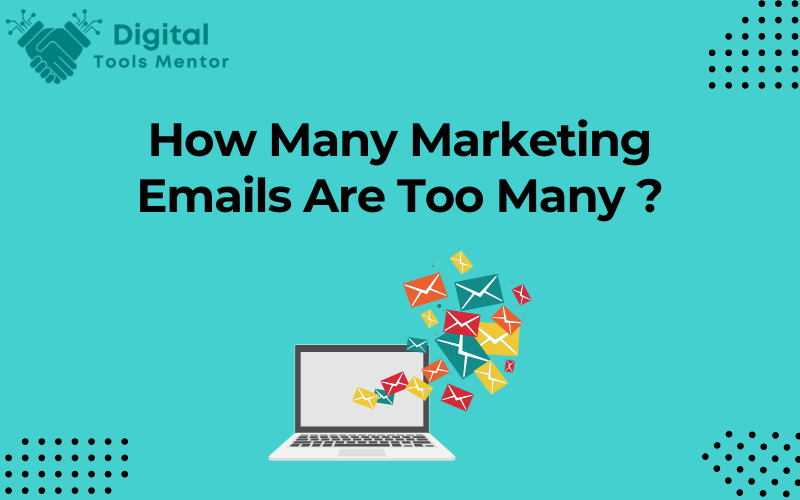How Many Marketing Emails Are Too Many?
In today’s digital age, email marketing has become a powerful tool for businesses to connect with their audience. However, finding the sweet spot between maintaining engagement and overwhelming subscribers with an excessive number of marketing emails is a challenge. The question on every marketer’s mind is: “How many marketing emails are too many?” In this blog, I will delve into this intriguing question and explore the factors that determine the ideal email frequency. By considering individual preferences, avoiding email fatigue, focusing on quality over quantity, and seeking feedback from subscribers, we can strike the right balance in our email marketing strategy. Join us as we unravel the secrets behind achieving the perfect equilibrium and discover how to keep subscribers engaged while respecting their inbox space.
How Many Marketing Emails Are Too Many? 7 Key Factors To Consider
1. Relevance To The Recipient
At the heart of effective email marketing is ensuring your messages are relevant to the recipient. Every individual on your email list has a unique set of interests, behaviors, and needs. When you send out generic emails that don’t resonate, they’re likely to be ignored or even lead to unsubscribes. Instead, utilize the data you have about each subscriber. Where are they in the buyer’s journey? What products have they shown interest in? What content do they engage with most?
Tailored content that aligns with the recipient’s interests and current needs is more likely to be opened, read, and acted upon. Use behavioral triggers to send specific emails. For instance, if a customer left items in their shopping cart without purchasing, a well-timed, targeted email might nudge them towards completing the sale. Ultimately, the frequency of emails becomes secondary if each email brings value to the recipient. It’s less about sending fewer emails and more about sending the right emails.
2. Individual Preferences
It’s essential to recognize that every individual has unique email preferences. While some subscribers might appreciate daily updates, others might prefer weekly or even monthly summaries. Understanding and respecting these preferences can significantly enhance your email marketing success. Many email marketing platforms allow subscribers to set their own frequency preferences. This ensures that you’re not overwhelming anyone and reduces the chances of subscribers opting out entirely.
To implement this, consider sending a welcome email to new subscribers, giving them the option to choose how often they’d like to hear from you. Always provide a clear and easy way for subscribers to change their preferences later on. By honoring individual preferences, you show that you value and respect your subscribers, fostering a stronger relationship and trust.
3. Avoiding Email Fatigue
Email fatigue happens when recipients receive too many emails, leading to decreased engagement and increased unsubscribe rates. It’s essential to strike a balance in your email frequency to avoid overwhelming your subscribers. Continuously bombarding subscribers with messages can lead to your emails being ignored, marked as spam, or leading to an unsubscribe.
Monitoring your email metrics can provide insights into email fatigue. If you notice a decline in open rates, an increase in unsubscribe rates, or lower click-through rates, it might be an indication that you’re sending too many emails. It’s essential to find the sweet spot – that perfect frequency where you’re engaging your audience without causing fatigue. Remember, it’s always better to have subscribers eagerly anticipating your emails than dreading them.
4. Quality Over Quantity
In the quest to maintain a consistent presence in your subscriber’s inboxes, there’s a danger of sacrificing quality for quantity. It’s crucial to prioritize the value and relevance of your content over the sheer number of emails you send. One well-crafted, highly targeted email can have a much more significant impact than several generic ones.
Before hitting send, ask yourself: Does this email provide value to the recipient? Is it informative, entertaining, or offering a beneficial deal? If the answer is no, reconsider its purpose. A focus on quality ensures that your subscribers always receive content that is of interest to them, making them more likely to engage with your brand and less likely to unsubscribe.
5. Testing And Monitoring
The world of email marketing is dynamic, and what works today might not work tomorrow. Regularly testing and monitoring your email campaigns is crucial. A/B testing different elements, such as subject lines, content, and sending times, can provide insights into what resonates most with your audience. Monitoring metrics like open rates, click-through rates, and conversion rates can indicate the success of your campaigns.
If you notice that certain emails have particularly high engagement, delve deeper to understand why. Was it the content, the timing, or maybe a compelling call-to-action? Conversely, if certain emails underperform, try to identify potential reasons. Regular testing and monitoring allow for continuous refinement of your email strategy, ensuring optimal performance.
6. Preference Centers
Preference centers are an effective way to give subscribers control over the emails they receive. They allow subscribers to choose their preferred email frequency, types of content they’re interested in, and even the format of emails. By offering such customization, you enhance the user experience and show that you value their preferences.
Having a preference center reduces the chances of subscribers getting overwhelmed and helps avoid un-subscriptions. It also provides valuable data on what your subscribers are genuinely interested in, allowing you to further tailor your email campaigns. By respecting and acting on your subscribers’ preferences, you foster a more engaged and loyal audience.
7. Seek Feedback
Feedback is a goldmine of information. Regularly seeking feedback from your subscribers can provide insights into how they perceive the frequency, relevance, and value of your emails. Surveys, polls, or even direct questions within emails can be used to gather feedback. Ask questions like: Are you satisfied with the frequency of our emails? Is there specific content you’d like to see more or less of?
By actively seeking feedback, you show subscribers that you value their opinions, and you’re committed to meeting their needs. The insights gained can be used to refine your email marketing strategy, ensuring that you’re always aligned with your subscribers’ preferences and expectations.
What Happens When You Send Too Many Emails?
When you send too many emails, several negative consequences can occur. Here are five key points highlighting what happens when you overload your subscribers’ inboxes:
1. Subscriber Fatigue
Overwhelming your subscribers with a high volume of emails can lead to email fatigue. When recipients receive an excessive number of emails from a single sender, they may become disengaged, lose interest, or even unsubscribe from your email list.
2. Decreased Engagement Rates
Sending too many emails can result in decreased engagement rates. Subscribers may ignore or delete emails without even opening them, reducing open rates and click-through rates. This decline in engagement can impact your overall email marketing effectiveness.
3. Increased Spam Complaints
Bombarding subscribers with an overwhelming number of emails increases the likelihood of spam complaints. When recipients feel inundated with unwanted or irrelevant messages, they may mark your emails as spam, negatively impacting your sender reputation and deliverability.
4. Unsubscribes
Excessive email frequency can lead to a higher unsubscribe rate. When subscribers feel overwhelmed or perceive your emails as intrusive, they may choose to opt-out of receiving further communication from your brand, resulting in a loss of potential customers.
5. Damage To Brand Reputation
Sending too many emails can damage your brand reputation. If subscribers perceive your brand as overly aggressive or pushy, it can erode trust and make it more challenging to engage them in the future. Negative brand sentiment and poor reputation can have long-term consequences for your marketing efforts.
To maintain a positive relationship with your subscribers, it is crucial to strike a balance in email frequency, ensuring that you provide valuable and relevant content without overwhelming their inboxes.
How To Find The Right Email Frequency
Finding the right email frequency is crucial for maintaining engagement and preventing subscriber fatigue. Here are five main points to consider when determining the optimal email frequency:
1. Analyze Audience Preferences
Pay attention to your subscribers’ preferences and behaviors. Use data and analytics to gain insights into their engagement patterns, such as open rates, click-through rates, and unsubscribe rates. Segment your audience and conduct surveys or collect feedback to understand their expectations regarding email frequency.
2. Quality Over Quantity
Focus on delivering high-quality content rather than bombarding subscribers with frequent but irrelevant emails. Ensure that each email provides value, whether it’s educational information, exclusive offers, or personalized recommendations. By consistently offering valuable content, you can maintain engagement even with a lower email frequency.
3. Test And Monitor
Implement A/B testing to gauge the impact of different email frequencies. Split your audience into groups and send emails at varying frequencies to see which generates the highest engagement. Monitor the results, including open rates, click-through rates, and conversion rates, to identify the optimal email frequency that resonates with your audience.
4. Consider The Customer Journey
Align your email frequency with your customer journey. Different stages of the customer journey may require different levels of communication. For example, during the onboarding process, new subscribers may benefit from more frequent emails to get acquainted with your brand. However, once they become regular customers, a less frequent but targeted approach may be more appropriate.
5. Provide Customization Options
Allow subscribers to have control over their email preferences. Implement preference centers that enable them to choose their preferred email frequency. This empowers subscribers to receive emails at a frequency that suits their needs, ensuring a more personalized and satisfying experience.
By analyzing audience preferences, focusing on quality, testing and monitoring, considering the customer journey, and providing customization options, you can find the right email frequency that strikes a balance between maintaining engagement and respecting your subscribers’ preferences.
How Many Marketing Emails Are Too Many? Conclusion
Determining the optimal number of marketing emails is a delicate balance that requires careful consideration. While there is no definitive answer to the question of how many marketing emails are too many, it ultimately depends on various factors such as relevance, individual preferences, and maintaining a healthy engagement rate. It is crucial to prioritize quality over quantity, ensuring that each email provides valuable content that resonates with the recipient. Regular testing, monitoring, and seeking feedback from subscribers are essential to fine-tune your email frequency. By finding the right equilibrium, businesses can effectively engage their audience, prevent email fatigue, and maintain a positive relationship with subscribers. Remember, the key lies in understanding your audience, respecting their preferences, and delivering compelling content that keeps them eagerly anticipating your next email.




